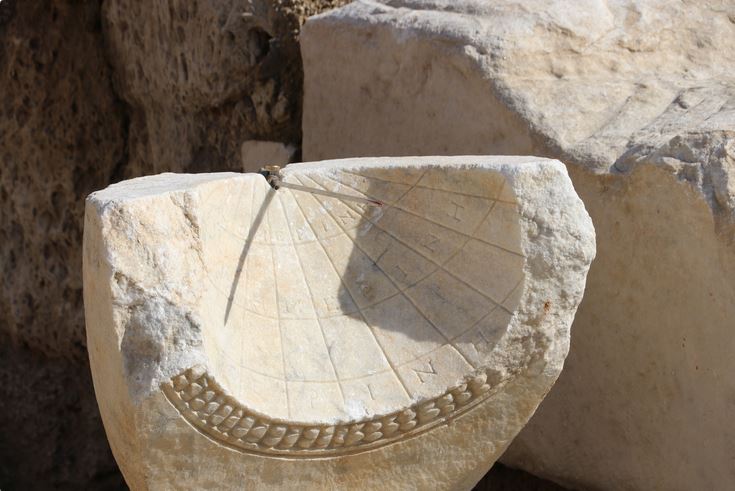 Several years ago in 2017 archaeologists found a rare hemicyclium sundial. Now another hemicyclium in excellent condition has been unearthed in Turkey's city of Denizli. Celal Şimşek, chief archaeologist at Denizli's Pamukkale University, calls it "unique". A better word is rare. Less than a hundred examples of this type of Hellenistic sundial have survived. It was found in the ancient city of Laodicea about 370 miles south of Istanbul. The sundial seems to have come from the archaeological site of one of the temples. As reported in the Daily Sabah, "Among the rare, largely preserved buildings in the city are the largest ancient stadium in Turkey, a theater and a sacred agora." The hemicyclium of pink marble has an outer edge decorated in foliage while the interior hemisphere has the traditional Greek names of the seasons. Hour lines deliniate the time. Almacantor lines show the solstices and a great circle marks the equinox. In AA Photo of the sundial at right, a needle gnomon has been restored to show how the sundial casts a shadow. Time and season are read at the gnomon shadow's tip.
Several years ago in 2017 archaeologists found a rare hemicyclium sundial. Now another hemicyclium in excellent condition has been unearthed in Turkey's city of Denizli. Celal Şimşek, chief archaeologist at Denizli's Pamukkale University, calls it "unique". A better word is rare. Less than a hundred examples of this type of Hellenistic sundial have survived. It was found in the ancient city of Laodicea about 370 miles south of Istanbul. The sundial seems to have come from the archaeological site of one of the temples. As reported in the Daily Sabah, "Among the rare, largely preserved buildings in the city are the largest ancient stadium in Turkey, a theater and a sacred agora." The hemicyclium of pink marble has an outer edge decorated in foliage while the interior hemisphere has the traditional Greek names of the seasons. Hour lines deliniate the time. Almacantor lines show the solstices and a great circle marks the equinox. In AA Photo of the sundial at right, a needle gnomon has been restored to show how the sundial casts a shadow. Time and season are read at the gnomon shadow's tip.
Read more at: https://www.dailysabah.com/life/history/2000-year-old-sundial-unearthed-in-southern-turkeys-denizli
ADDENDUM FROM SUNDIAL DIGEST - 10 April 2020
I would like to add two arguments to the questions [of the sundial's age] under discussion:
1. Prof. Şimşek said: “On the North Parados passage in the Western Theater, which dates back to the Hellenistic Era, in the ancient city we have found a spherical sundial facing south, which we believe to be 2,020 years old.
This is a kind of conclusion which does not help by dating the dial. A comparison with similar specimens reveals that it was probably done around 200 – 400 CE.
2. “Inscribed on the dial are the Greek word ‘Ksimerini’, or winter on the upper part; ‘Isimerini’, or solstice, which denotes the equality of day and night in the middle; and ‘Terini’, or summer in the bottom.”
I read (ΤΡΟΠH) ΧΕ(Ι)ΜΕΡΙΝH / IΣΗΜΕΡΙΝH / (ΤΡΟΠH) ΘΕΡΙΝH.
These are the names of the solstices and the equinoxes. What is conspicuous is the missing of I in χειμερινή (it should be written with diacritic signs). That is another strong argument that it was done in the Roman era.
With best wishes
Karlheinz Schaldach
